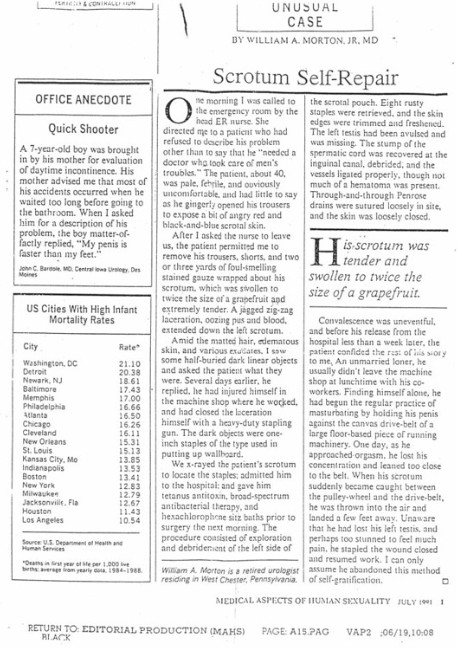To get the ball rolling, I like the way Dave McGowen debunks the “oil comes from dinosaurs” myth in one of his newsletters: www.davesweb.cnchost.com/nwsltr52.html
Oil comes from dinosaurs – Dave McGowen
“As everyone knows, oil
comes from dinosaurs. I remember as a kid seeing some kind of ‘public
service’ spot explaining how dinosaurs “gave their all” so that we could
one day have oil. It seemed a reasonable enough idea at the time — from
the perspective of an eight year old. But if, as an adult, you really
stop to give it some thought, doesn’t the idea seem a little, uhmm …
what’s the word I’m looking for here? … oh yeah, I remember now …
preposterous?
How could dinosaurs have
possibly created the planet’s vast oil fields? Did millions, or even
billions, of them die at the very same time and at the very same place?
Were there dinosaur Jonestowns on a grand scale occurring at locations
all across the planet? And how did they all get buried so quickly?
Because if they weren’t buried right away, wouldn’t they have just
decomposed and/or been consumed by scavengers? And how much oil can you
really squeeze from a pile of parched dinosaur skeletons?

Maybe there was some type
of cataclysmic event that caused the sudden extinction of the dinosaurs
and also buried them — like the impact of an asteroid or a comet. But
even so, you wouldn’t think that all the dinosaurs would have been
huddled together waiting to become oil fields. And besides, scientists
are now backing away from the mass extinction theory.
It would take a pretty big
pile of dead dinosaurs to account for the estimated 660 billion barrels
of oil in the Middle East. I don’t know what the precise
dinosaur-carcass-to-barrel-of-oil conversion rate is, but it does seem
like it would take a hell of a lot of dead dinosaurs. Even if we
generously allow that a single dinosaur could yield 50 barrels of oil
(an absurd notion, but let’s play along for now), more than 130 billion
dinosaurs would have had to be simultaneously entombed in just one small
region of the world. But were there really hundreds of billions of
dinosaurs roaming the earth? If so, then one wonders why there is all
this talk now of overpopulation and scarce resources, when all we are
currently dealing with is a few billion humans populating the same
earth.

And why the Middle East?
Was that region some kind of Mecca for dinosaurs? Was it the climate, or
the lack of water and vegetation, that drew them there? Of course, the
region could have been much different in prehistoric times. Maybe it was
like the Great Valley in the Land Before Time movies. Or maybe the
dinosaurs had to cross the Middle East to get to the Great Valley, but
they never made it, because they got bogged down in the desert and
ultimately became cans of 10W-40 motor oil.
Another version of the
‘fossil fuel’ story holds that microscopic animal carcasses and other
biological matter gathered on the world’s sea floors, with that organic
matter then being covered over with sediment over the course of millions
of years. You would think, however, that any biological matter would
decompose long before being covered over by sediment. But I guess not.
And I guess there were no bottom-feeders in those days to clear the
ocean floors of organic debris. Fair enough. But I still don’t
understand how those massive piles of biological debris, some consisting
of hundreds of billions of tons of matter, could have just suddenly
appeared, so that they could then sit, undisturbed, for millions of
years as they were covered over with sediment. I can understand how
biological detritus could accumulate over time, mixed in with the
sediment, but that wouldn’t really create the conditions for the
generation of vast reservoirs of crude oil. So I guess I must be missing
something here.
The notion that oil is a
‘fossil fuel’ was first proposed by Russian scholar Mikhailo Lomonosov
in 1757. Lomonosov’s rudimentary hypothesis, based on the limited base
of scientific knowledge that existed at the time, and on his own simple
observations, was that “Rock oil originates as tiny bodies of animals
buried in the sediments which, under the influence of increased
temperature and pressure acting during an unimaginably long period of
time, transform into rock oil.”
Two and a half centuries
later, Lomonosov’s theory remains as it was in 1757 – an unproven, and
almost entirely speculative, hypothesis. “Although the world has been
drilling for oil for generations, little is known about the nature of
the resource or the underground activities that led to its creation.”
The Wall Street Journal, “In spite of the great amount of scientific
research … there remain many unresolved questions regarding its
origins.” – Encyclopedia Britannica
Does that not seem a
little odd? We are talking here, after all, about a resource that, by
all accounts, plays a crucial role in a vast array of human endeavors
(by one published account, petroleum is a raw ingredient in some 70,000
manufactured products, including medicines, synthetic fabrics,
fertilizers, paints and varnishes, acrylics, plastics, and cosmetics).
By many accounts, the very survival of the human race is entirely
dependent on the availability of petroleum. And yet we know almost
nothing about this most life-sustaining of the earth’s resources. And
even though, by some shrill accounts, the well is about to run dry, no
one seems to be overly concerned with understanding the nature and
origins of so-called ‘fossil fuels.’ We are, rather, content with
continuing to embrace an unproved 18th century theory that, if subjected
to any sort of logical analysis, seems ludicrous.”

In 1970 the Russians
started drilling Kola SG-3, an exploration well which finally reached a
staggering world record depth of 40,230 feet. Since then, Russian oil
companies have quietly drilled more than 310 successful super-deep oil
wells, and put them into production. In 2003 Russia overtook Saudi
Arabia as the world’s biggest single oil producer, and is now set to
completely dominate global oil production and sales for the next
century.

If this report started by
claiming that completely unlimited crude oil reserves exist inside
planet earth, readers might be tempted to regard the entire text as
preposterous ghostwriting for a novelist like Frederick Forsyth. If the
report then went on to claim that the Russians have exploited this
stunning reality for nearly thirty years, right under the largely
unwitting noses of western intelligence, readers could be excused for
mistaking the author for a lunatic, or perhaps as a front for spy
novelist John le Carré. The problem here is that unlimited oil reserves
do exist inside planet earth, and the Russians long ago developed the
advanced technology necessary to recover these unlimited oil reserves in
an efficient and timely manner.
Profoundly disturbing hard
intelligence like this does not sit well with the frantic cries of
western academic shills and lobbyists, determined to convince you all
that the end of the oil world is nigh, or, more accurately, that America
faces an imminent catastrophe when global production capacity “Peaks”,
i.e. when world demand for crude oil finally exceeds the rate at which
we can physically pump the required product out of the ground.
In order to understand how
Russia has left the rest of the world standing in its wake, it is
essential to know a little bit about where oil is located, and how it is
extracted from the ground for refining and commercial use. The theory
underlying how oil is formed at such enormous depths in the mantle of
the earth is not central to this report, because the Russians have
already proved its point of origin in absolute drilling terms more than
300 times. Those interested in the exact process should research the
archives, where there are more than two hundred Russian papers on the
subject. Probably a good place to start would be “The Role of Methane in
the Formation of Mineral Fuels”, written by by A.D. Bondar in 1967.
What is central to this report is the massive advantage that Russia’s
ultra-deep drilling discoveries and technical achievements give it over
the western nations.

Let’s just be clear about this:
Russia is officially the world’s largest exporter of natural gas, and the world’s second largest oil exporter.
In 2006, Russia’s GDP grew
by 6.7 percent, surpassing average growth rates in all other G8
countries – the country’s seventh consecutive year of economic
expansion.
Russia’s economic growth has been driven primarily by energy exports.
In 2007, Russia generated 64% of its export revenues from oil and gas exports.
A US$1 per barrel increase in oil prices for a year is estimated to raise Russia’s federal budget revenues by US$3.4 billion.
This is not a “theory”, nor is it a “conspiracy” – Russia drills deep wells and finds plenty of oil, which it exports.
The oil that Russia exports is not “fossil fuel” – it’s abiotic oil.
Fossil Fuel vs. Abiotic Oil
It appears that,
unbeknownst to Westerners, there have actually been, for quite some time
now, two competing theories concerning the origins of petroleum.
One theory claims that oil
is an organic ‘fossil fuel’ deposited in finite quantities near the
planet’s surface. The other theory claims that oil is continuously
generated by natural processes in the Earth’s magma. One theory is
backed by a massive body of research representing fifty years of intense
scientific inquiry. The other theory is an unproven relic of the
eighteenth century. One theory anticipates deep oil reserves, refillable
oil fields, migratory oil systems, deep sources of generation, and the
spontaneous venting of gas and oil. The other theory has a difficult
time explaining any such documented phenomena.
So which theory have we in
the West, in our infinite wisdom, chosen to embrace? Why, the
fundamentally absurd ‘Fossil Fuel’ theory, of course – the same theory
that the ‘Peak Oil’ doomsday warnings are based on.
Dave McGowan
This mass embracing of the fossil fuel myth is so fruitloops it’s enough to make anyone freak out….

It’s strange how no one ever says “fossil
fuel THEORY”, but Abiotic oil is ALWAYS referred to as a theory. What
ever made fossil fuel the reality and abiotic oil the theory? Certainly
not facts, evidence, or even plausability….
Oil can be produced
virtually anywhere on earth, provided the host country can afford the
expensive technology, and the massive cost of drilling a well to extreme
depth through extremely hard rock formations. But just think what even
20 or 30 deep producing oil wells can mean for the people of a country
that has no natural resources of its own, or worse still, for people who
have been told by western lobbyists that they have no natural resources
of their own. Anyone who can prove that the western nations were lying
or simply wrong, will become a trusted friend forever. Vietnam is a
classic example.
After more than 60 years
of being enslaved, pillaged, and raped by the French and then by the
Americans, the poor Vietnamese were told officially by American oil
multinationals that their country was barren; that western ‘cutting
edge’ technology had failed to find anything to help them recover
financially from the mess left behind by American bombs, Agent Orange,
and a host of other delightful gifts from Uncle Sam. This of course was
exactly where America wanted the Vietnamese to be: desperately poor and
unable to take action against their former invaders.
The Russians had other
ideas and a very different approach. After telling the Vietnamese that
the Americans had lied to them, oil experts were flown in from Moscow to
prove this startling claim in a no-risk joint venture, meaning the
Russians would provide all of the equipment and expertise free of
charge, and only then take a percentage of the profits if oil was
actually found and put into production. Vietnam had absolutely nothing
to lose, and swiftly gave Russia the green light.
The White Tiger project
was the first outside Russia to openly exploit and showcase this
ultra-deep technology and oil production from basalt rock to the world.

White Tiger Oilfield – Vietnam
And let’s be clear about this as well:
Despite US oil companies previously telling the Vietnamese that they had no oil, the US Government now readily admits that Vietnam is a producer and exporter of oil – in fact they now buy oil from them!
Vietnam held 600 million barrels of proven oil reserves as of January 2007.
Vietnam’s oil production has increased steadily over the last two decades.
In 2006, Vietnam produced
an estimated 362,000 bbl/d (barrels per day) of oil. EIA forecasts that
the country’s oil production will rise above 400,000 bbl/d in 2008.
Vietnam exported about
125,000 bbl/d of crude oil to Australia, 40,000 bbl/d to the United
States, and 30,000 bbl/d to Japan in 2006. Industry sources report that
Vietnam also exports oil to Singapore and Thailand.

Source : EIA – Energy Information Administration (US Gov)
Cars can run fine on alcohol too
Most people are not aware that Henry Ford’s Model T came in a variation
that allowed the driver to switch the carburetor to run the engine on
farm-made ethyl alcohol. This allowed the operator to stop at local farms
(equipped with stills) to refuel his car during long trips through the
backcountry. After all- the gas station wasn’t exactly as ubiquitous in
those days, as it is now. The Standard Oil Company and its
industrialist-founder John D. Rockefeller wasn’t too happy with this
arrangement. After all, Rockefeller’s company had a virtual monopoly on
gasoline at this time in our nation’s development.
Since the late 1800’s there had been a growing Alcohol Temperance Movement
developing among reformers. Rockefeller saw an opportunity in this. It is
well-documented that local efforts to curb alcohol consumption were
expanded to the national level when high-profile figures like Rockefeller
joined in the anti-alcohol efforts. Was he so concerned with the social
problems that abuse of alcohol was said to cause?
No… John D. Rockefeller was not concerned with family dynamics in the
working classes. But he was influential in changing the goals of the
movement from temperance to prohibition. He gave the equivalent of $60
million in today’s dollars to an obscure group pushing for prohibition
called the Women’s Christian Temperance Union. As we know, his
contribution to the outlawing of the production and sale of alcohol was
successful. Of course, Rockefeller and the oil companies reaped tremendous
profits as a result. Remember that the period covered by the 18th
Amendment (1919-1933) coincided with the huge rise in the sale and
operation of automobiles. America was on the move, and all of these cars
were now operated solely on gasoline. By the time that the 21st Amendment
was passed, ending the prohibition of alcohol, the standard was already
set and worked completely in the favor of the Rockefeller family.

The difference between scarcity and abundance is price – Greg Palast
The number one theorem of
economics is that we are running out of everything and yet we can have
as much as we want of anything. There’s no contradiction. All
commodities are scarce and abundant at the same time. The difference
between scarcity and abundance is price. You can get anything, in any
amount, if you are willing to pay any price.
On its face, Hubbert’s
Peak Oil Study was stone cold manipulative nonsense, measurably so. But
we are running out of a certain kind of oil nevertheless: cheap oil.
That is, we are coming to the end of the stuff we can pump at a low
cost, the easy oil that practically jumps out of the ground. When we
bring price into the equation, Hubbert was correct – technically. Oil
production did peak in the 1970s – for a certain type of oil. Re-read
Hubbert. When he wrote his analysis, oil was selling below $3 a barrel,
just over $20 in today’s dollars, and falling. Therefore, as prices
declined further, we’d run out. We did. We’ve pretty much run out of new
oil fields we can “lift” for $20 a barrel. Even the cheapest untapped
fields in the world – not coincidentally in Iraq – will cost more than
the “Hubbert price” to suck up and pipe out.

At low prices, there’s not much oil. As prices rise, so does supply.
It’s not magic. At $30 a
barrel, Oklahoma stripper wells are worth reopening, drilling in the
Gulf of Mexico becomes profitable in 3,000 feet of water, Kazakhstan’s
crude is worth piping out even with the high cost of transportation and
bribes.
To simplify: World oil
reserves, officially measured at 1.189 trillion barrels, are probably,
as one of Mr. Hubbert’s protégés stated a few years back, grossly
overstated – if you assume oil selling at $10 a barrel. But kick the
price up to a post-invasion $50 a barrel, and the world reserves are
wildly understated.
Reserves are the measure
of oil recoverable at a certain price. Raise the price, raise the
reserve. Cut the price and the amount of oil in the ground drops. In
other words, it’s a fool’s errand to measure the “amount of oil we have
left.” It depends on the price. At $9 a barrel (the price in 1998),
we’ve peaked. It’s over. All gone. But at $70 a barrel (reached in the
third year of the Iraq occupation), miracles happen. Oil gushes forth
like manna. How much more? If you are willing to pay $70 a barrel – and
apparently you are – it’s worth it to melt sand and drain out the
petroleum.
Indeed, the “tar sands” of
Alberta, Canada, hold 280 billion barrels of oil-for enough high octane
to run our Humvees for a century. Canada’s tar oil reserves are,
notably, about 15% higher than the oil reserves of Saudi Arabia. It’s
not pie-in-the-sky stuff. America is dependent on foreign oil – but not
from Arabia. Our biggest source of oil is Canada and half of the
Canadian supply today comes from tar sands. And that will grow. How
could Hubbert have missed all this oil? Answer: He didn’t. On page 20 of
his famous “Peak Oil” study, he accepts that the planet can yield up
800 billion barrels of oil from tar sands equal to all the “crude”
(i.e., liquid) oil we are using up.
So where did Hubbert get
the idea that we are running out of oil? He didn’t. He made no such
prediction. Quite the opposite, he said, after predicting “the
culmination of world production” by 2006, he noted, “This does not
necessarily imply that the United States or other parts of the
industrial world will soon become destitute of liquid and gaseous
fuels…”

Peak oil is a major problem for Exxon Mobil
Exxon Mobil Posted the Biggest Annual and Quarterly Profits Ever by a U.S. Company, on February 1 2008
Exxon posted the largest
annual profit by a U.S. company – $40.6 billion – as the world’s largest
publicly traded oil company profited from record crude prices at year’s
end.
Exxon also set a U.S.
record for the biggest quarterly profit, posting net income of $11.7
billion for the final three months of 2007.
In 2006, Exxon Mobil
reported a profit of $39.5 billion, at that time the largest annual
profit ever for an American company, and its revenue of $377.6 billion
exceeded the gross domestic product of all but 25 countries, but despite
the massive problem of “peak oil”, they have managed to set a new
record again.

Exxon chairman and CEO Lee Raymond is totally bummed out about peak oil….
How the US Government uses tax benefits to encourage higher fuel consumption
Under the United States income tax code, the cost of vehicles over 6,000 pounds (2722 kg) can be deducted from taxable income.
The actual value of this deduction averages 30% of the price of the vehicle in question.
The 2002 Tax Act increased this “Section
179 depreciation deduction” to US$75,000, and it rose again to
US$102,000 for the 2004 tax year.
– Wikipedia

The GM Humvee is one of the many sub 10 miles per gallon vehicles the US gov has promoted with massive tax benefits.
Strangly enough General Motors marketed
the Humvee straight after discontunuing the EV-1 electric car, which
they not only refused to market or sell, but also later confiscated from
all lease holders and crushed.
Whether or not the EV-1 was as good as it
was made out to be in the movie “Who Killed the Electric Car?” is
another story, but crushing them all and bringing out the Humvee is just
a little strange.

The biggest selling car in the world is the Toyota Corolla (average fuel consumption well over 30mpg)

But the number one selling vehicle in
America is the Ford F-150. (av fuel consumption under 12mpg) – and yes
amazingly enough it weighs in at over 6000 pounds – it’s 6250 pounds!!
(“why would that be?” – many rocket scientists ask each day)

As American waistlines have expanded
since 1960, so has their consumption of gasoline, researchers at the
University of Illinois say – in 2006 Americans were pumping 938 million
gallons of fuel more annually than they were in 1960 as a result of
extra weight in vehicles.
University Of Illinois – Oct 2006
(mmmm, I wonder if they really do mean extra weight “IN” vehicles, or was that supposed to be “OF” vehicles?)

Of course back in 1960 the cars in
America were more economical than today – OK, I am exaggerating, but
they really weren’t much different
The average mpg of US passenger cars in
1960 was 14 mpg, and although this did climb to 20 mpg by 1990, since
then it hasn’t changed much at all – as of 2005 it was still only 23
mpg.
But this covers up another dirty little
secret – all those heavy (over 6000 lbs) SUV’s, are defined as “trucks”,
so the really thirsty passenger cars in the US are not even counted as
cars – and that 23 mpg figure only includes the more “economical” cars
!!!
Given that up to half the American
passenger fleet is defined as a “truck” – that economical 23 mpg figure
may be a PR fantasy !!!!!
A government that does everything in
their power to encourage greater petrol consumption, could be said to be
less concerned with “oil dependency”, than oil profits.

The 1960 Cadillac was a guzzler – just like a Humvee – but at least it looked cool – not like a Humvee…
“Oil is not a fossil fuel.
In fact, oil is abiotic, not the product of long decayed biological
matter. For better or for worse, is not a non-renewable resource. Oil,
like coal, and natural gas, replenishes from sources within the mantle
of earth. This is the real and true science of oil.”
Jerry Mazza
“Peak oil is a scam to
create artificial scarcity and drive prices up. Meanwhile, alternative
fuel technologies which have been around for decades are intentionally
suppressed. The peak oil myth is peddled by the establishment-run fake
left activist groups and the IMF.”
Dr. Nick Begich
Marion King Hubbert was a geophysicist for Shell Oil Company in Houston
David Goodstein
oddly, the significance of this fact seems to be lost on peak oil theorists…
This is a big story. It’s
an attempt to create the illusion that the world is rapidly running out
of oil and within a few short years, we will experience unemployment,
wars, famine, and all manner of horrendous strife as a result of the
fallout from the now “rapidly vanishing” oil supplies. It’s a scam from
top to bottom.
Ken Adachi


Everyone knows oil is a fossil fuel that came from dinosaurs – there is no doubt about this, it’s perfectly reasonable

Dinosaurs were so massive they had over 50 barrels of oil in them each






.png)









































